What Constitutes Autonomy in Digital Communication?
BA New Media / Online Communication KF/BF A
Spring Term 2023
Johannes Gutenberg University Mainz
Welcome!
Welcome to this course!
- You can navigate through the sessions horizontally and within the sessions vertically
- Use your arrow keys
- Use
Mto open the menu - You can find the course website and all slides at https://felixdidi.github.io/23-1-nmok/
- Press
?on your keyboard to learn more about how to navigate the slides!
Session 01: Introduction

Resources for this session
Welcome!
Getting Started
What are the main questions to be answered in this session?
- What is this course about?
- What will I learn?
- What will I (have to) do?
Course Website
- Available at https://felixdidi.github.io/23-1-nmok/
- Please read in detail after this session
Course Material
- Will be provided via the course website (and Moodle)
- Please check if you have access to the Moodle platform
- You should be added to the Moodle course automatically
- If you do not have access by the end of this week, please write an email
About

About Felix
- PhD-Student in Media Psychology
JGU Mainz - Teaching and Research Associate
JGU Mainz & Uni Mannheim
My research interests include:
- Digital autonomy and well-being
- Affordances of digital media & human-AI interaction
- Media entertainment experiences
- Open & computational communication science
What about you?
- What’s your name?
- What’s your major/minor?
- Prior experience in working with scientific literature on a specific topic (term papers, presentations, …)?
- Have you ever worked with GitHub before?
Some Disclaimers
Language will not be graded
The Westworld Dilemma
What Will I Learn?
Expertise
- Expertise about topics and questions in research on digital well-being
- Knowledge of the potentials and limitations of different theoretical approaches
- Ability to apply the acquired knowledge to new research areas and develop your own specific research questions
Methodological competence
- Independently deal with a broad and international literature base
- Systematize and synthesize empirical evidence from different perspectives towards a specific topic such as digital autonomy
- Independently and collaboratively work on a topic and present your results in a comprehensible manner
Personal competence
- Develop problem-solving competences with regard to questions from the field of media psychology
- Ability to structure, synthesize and transfer acquired knowledge
- Confidence to tackle your own research-oriented tasks in the future
What Will I Do?
Live Sessions
- Weekly live sessions
Reading Task
- Read the provided literature to prepare for a live session
- Use the questions that are provided at the end of the previous session to guide your reading
- You should be able to provide answers to these questions in class
How to read, and how not to read?
- Don’t read scientific literature like a novel
- Start with Title, Abstract, Subheadings to get a first impression
- If your are reading digitally, search for key words
- Think about “What do I want from this text?”
- Answer your own questions (I will also provide some)
What Will I Do?
Exercises (not graded)
- You will sometimes be provided with practical exercises
- These are intended to help you improve your competence with the learned topics
- Must be submitted until the following Sunday night after the live session via Moodle
Wiki Entry (Individual Submission, not graded)
- Collects entries about research on digital autonomy
- Very broad range of research fields to cover
Systematization & Synthesis (Group Project, partially graded)
- Collect, systematize and synthesize the heterogeneous research landscape on digital autonomy
- Group presentation in class (not graded)
- Group term paper (graded)
Graded Performance (“Prüfungsleistung”)
- To receive credit for this class, you must pass a “Prüfungsleistung”
- A: Group Submission, B: Individual Submission, C: No Submission
Course Overview (Part I)
Weekly Sessions
| Date | Topic |
|---|---|
| 19.04.23 | Introduction |
| 26.04.23 | The Mobile Connectivity Paradox: Digital Wellbeing as a Dynamic Construct |
| 03.05.23 | Autonomy as a Basic Psychological Need: The Framework of Self-Determination Theory |
| 10.05.23 | Structuring a Heterogeneous Field: The Basics of Markdown and GitHub |
| 17.05.23 | Wiki Project: What Constitutes Autonomy in Digital Communication? |
| 24.05.23 | Wiki Project: What Constitutes Autonomy in Digital Communication? |
| 31.05.23 | Wiki Project — No Class! |
Course Overview (Part II)
Weekly Sessions
| Session | Topic |
|---|---|
| 07.06.23 | Wiki Project — No class! |
| 14.06.23 | Systematization: What Constitutes Autonomy in Digital Communication? |
| 21.06.23 | Systematization: What Constitutes Autonomy in Digital Communication? |
| 28.06.23 | Systematization: What Constitutes Autonomy in Digital Communication? |
| 05.07.23 | Synthesis: SDT-focused Perspectives on Digital Autonomy and Their Contribution to the Field |
| 12.07.23 | Synthesis: Other Perspectives on Digital Autonomy and Relation to SDT |
| 19.07.23 | Concluding Thoughts & Evaluation |
Any Questions?
Prepare for the next session
To prepare for the next session, please read the paper by Vanden Abeele (2021).
After you have finished reading, try to answer the following questions:
- What is a good definition of digital well-being? How might this be associated with the concept of autonomy?
- Take a look at the table on pp. 941-942. Do you understand what all of the described factors mean? If not, try to find out and write down what you have found. If you are still not sure, write this down as well and bring your questions to the next session.
Session 02: The Mobile Connectivity Paradox — Digital Wellbeing as a Dynamic Construct
Any Questions about the Class?
Quiz Time
Is social media bad for (adolescents) mental health?

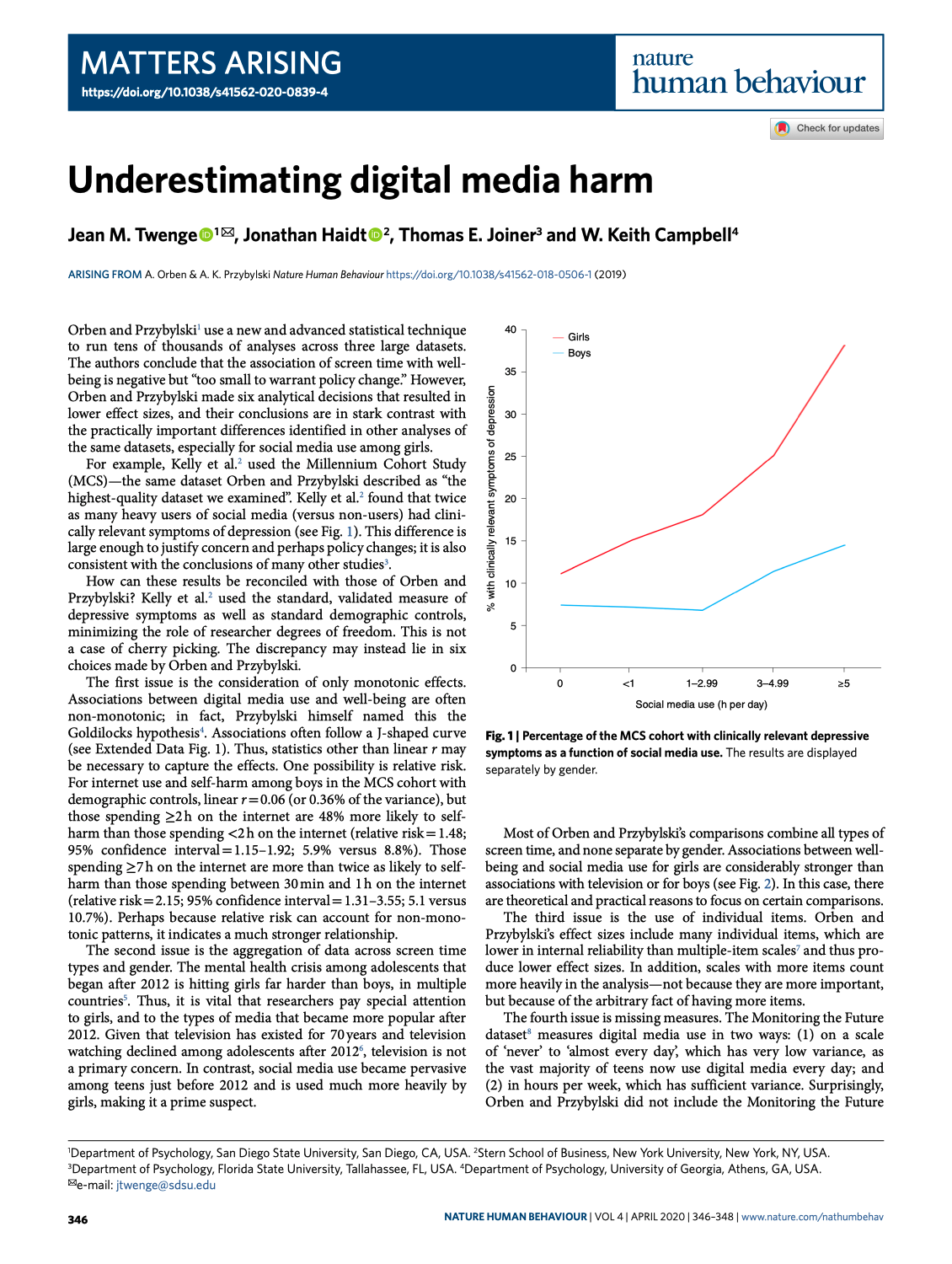
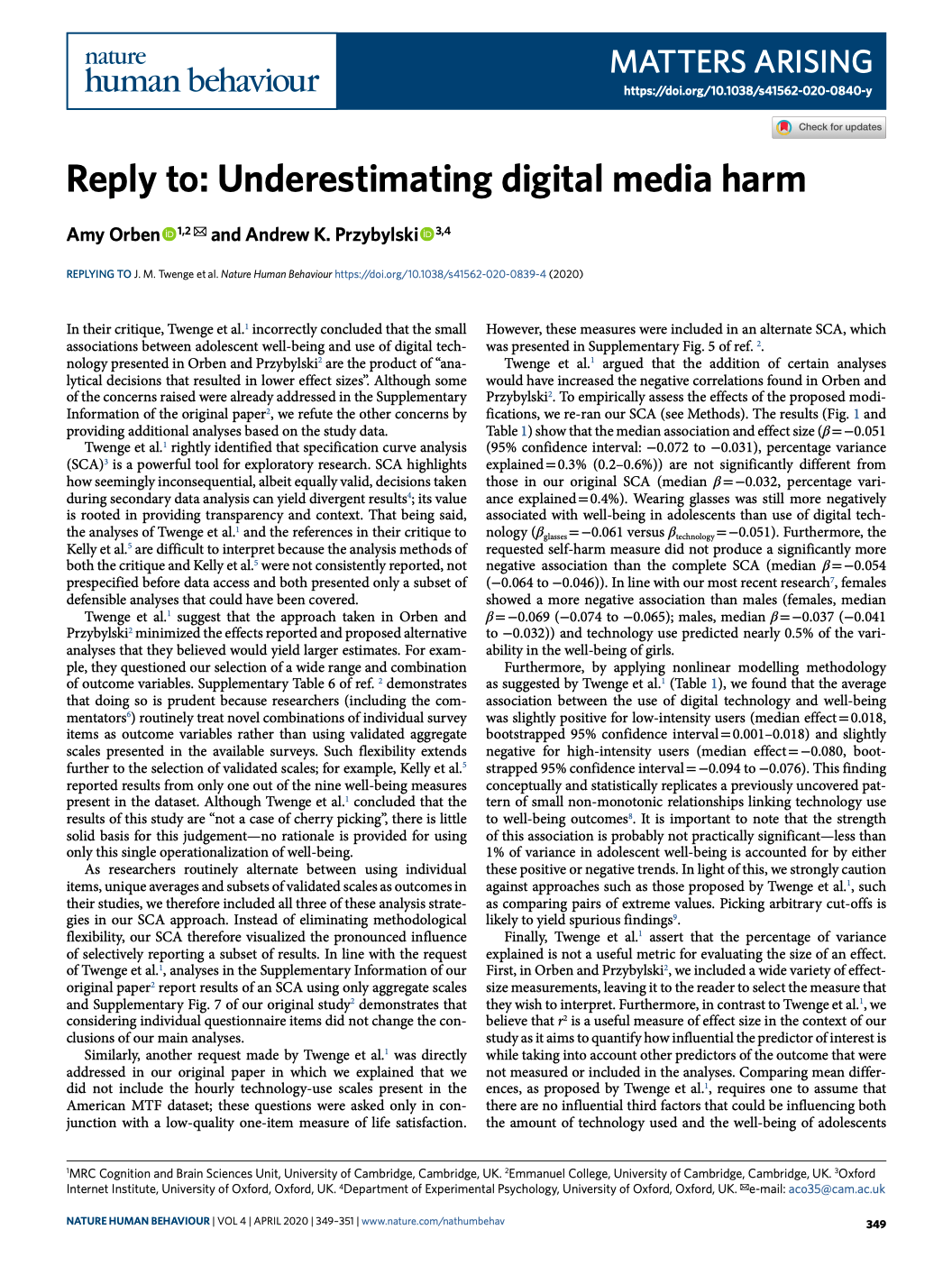
What is (digital) psychological well-being?
“Optimal psychological functioning and experience”
Ryan & Deci (2001, p. 142)
- Focus on happiness and life satisfaction
- Pleasure attainment (positive affect)
- Pain avoidance (avoiding negative affect)
- Sometimes named subjective well-being
- Focus on full functioning
- Meaning
- Self-realization, self-actualization
Two-continua models of mental health
in the context of computer-mediated communication, see Meier & Reinecke (2021)
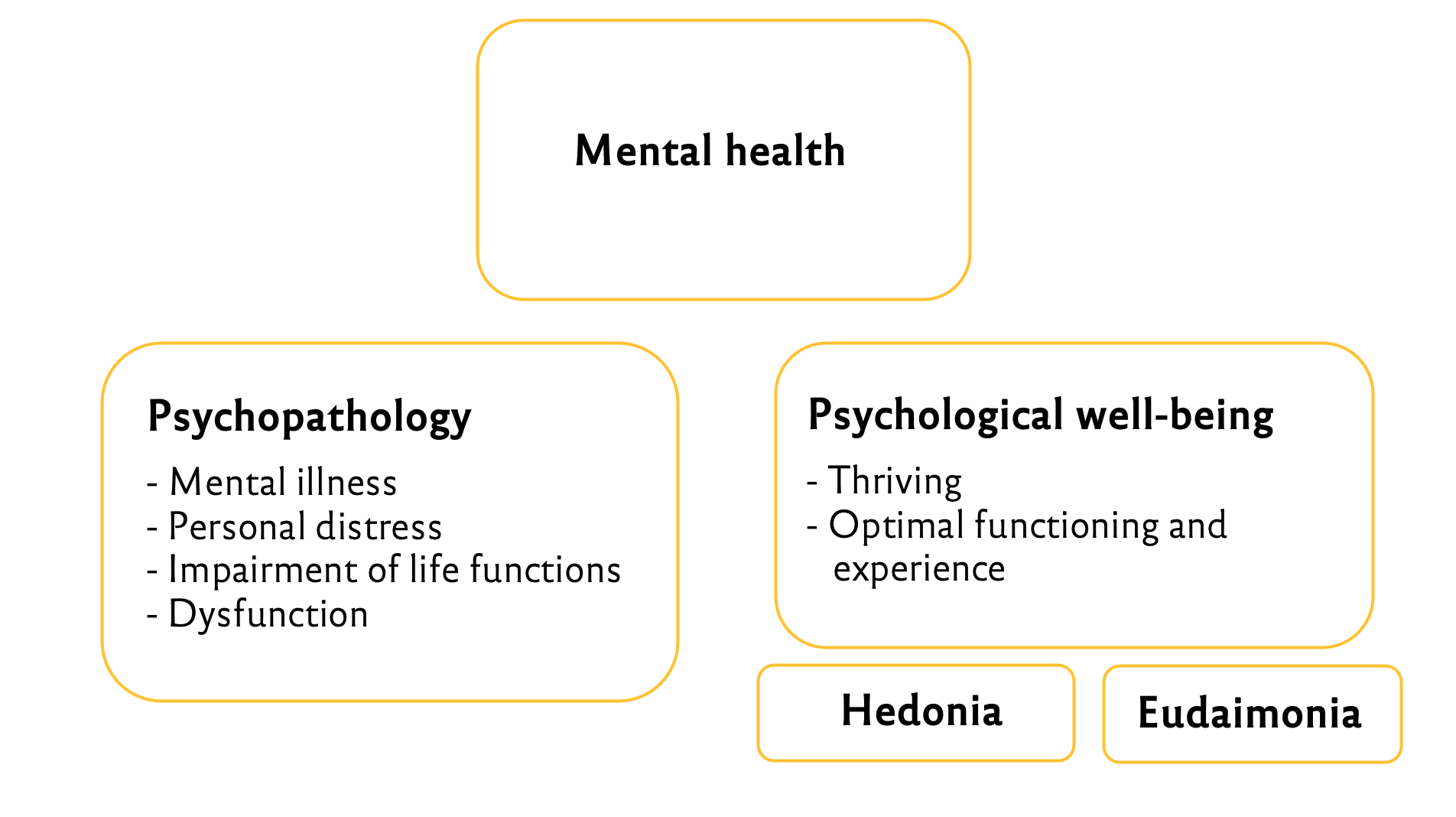
Definition of Digital Well-Being
“Digital wellbeing is a subjective individual experience of optimal balance between the benefits and drawbacks obtained from mobile connectivity. This experiential state is comprised of affective and cognitive appraisals of the integration of digital connectivity into ordinary life. People achieve digital wellbeing when experiencing maximal controlled pleasure and functional support, together with minimal loss of control and functional impairment.”
Vanden Abeele (2021, p. 938)
Autonomy Need Experiences as a Central Mediator Between Media Use and Well-Being
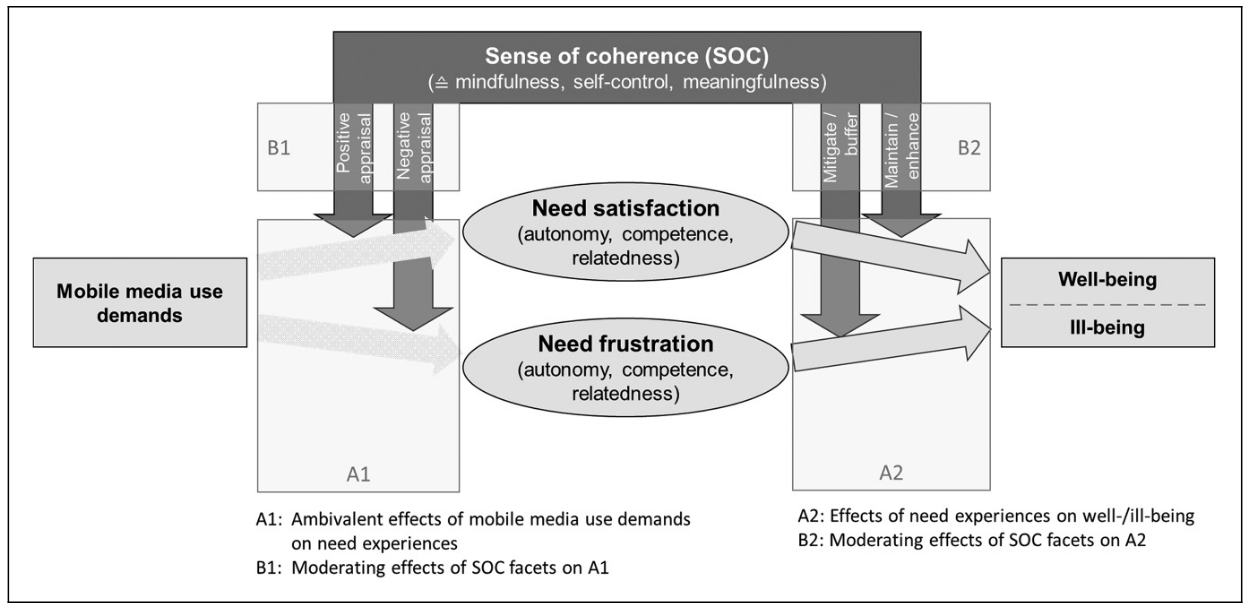
Integrative Model of Mobile Media Use and Need Experiences (IM3UNE)
What are “Demands”?
Lack of theoretical integration of the role of technological influencing factors in digital media use
- Affordances? (Karahanna et al., 2018)
- CMC-Taxonomy? (Meier & Reinecke, 2021)
- “Cold” Affordances? (Trepte, 2015)
- Machine Agency & Human-AI Interaction? (Hancock et al., 2020; Sundar, 2020)
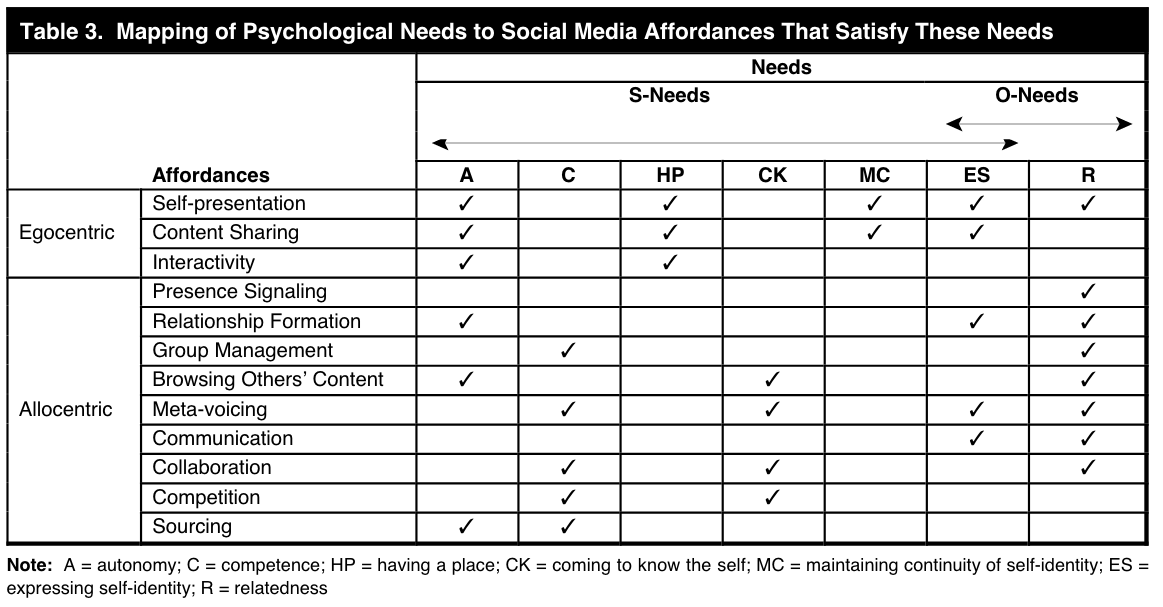
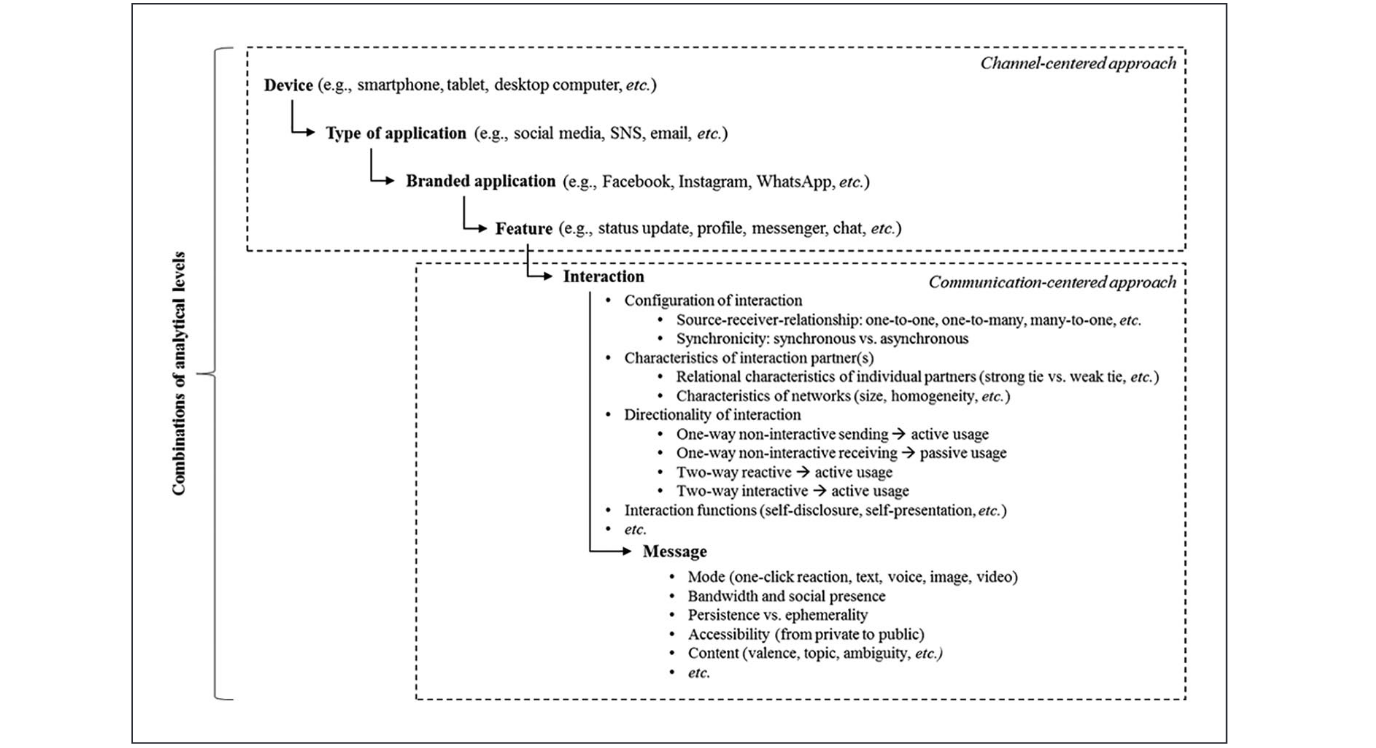
Many different terms, but autonomy still the (most) suitable term?
Let’s just take a look at what’s in the literature so far… → Literature Review.
Literature Review of Digital Autonomy
Problem: Very broad construct, very much literature, how to narrow down?
- Citation Chasing?
- Autonomy “Concept”?
- (Computational) Scoping Review
Step 1: Gain an overview with the help of Topic Modeling…
What is Topic Modeling?
- A corpus consists of \(D\) documents und \(V\) words (or terms): bag-of-words approach
- Assumption: there are latent clusters of topics \(K\) which occur to varying degrees within \(D\) and are indicated by specific words \(w\) which belong to each \(K\) with a specific probability
- Goal is the computation of two matrices: \(D*K\) and \(V*K\)
General Overview (Maier et al., 2018, p. 94)
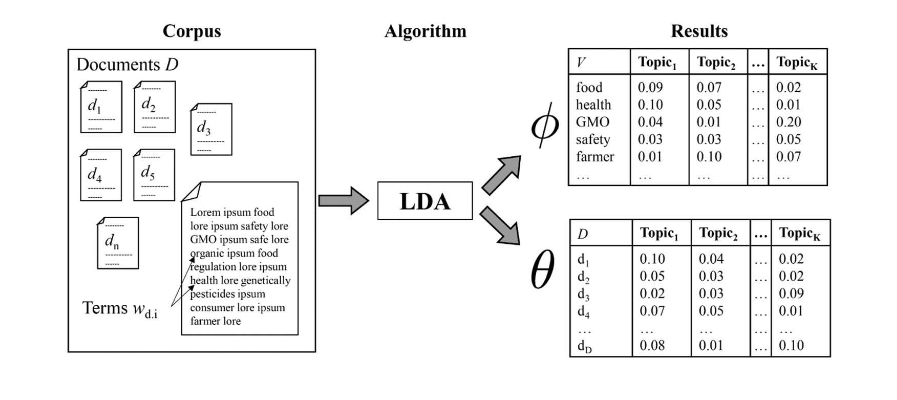
- \(\phi\) = Word-topic assignment matrix
- \(\theta\) = Document-topic assignment matrix
Computational Scoping Review

Topic model (k = 14) with corresponding top words (i.e., highest β probability for topic) and most likely OpenAlex concepts (highest level and probability score). Relative topic prevalence γ over entire corpus (n = 1744). Topic labels in grey boxes based on qualitative assessment.
Goals and Research Questions
Goal 1: Integrating Human Computer Interaction and Communication Research
- RQ1: What are the mechanisms that are proposed to connect digital media use and autonomy need experiences?
Goal 2: Integrating Other Perspectives on Digital Autonomy
- RQ2: Which research perspectives can be identified in the study of digital autonomy?
- RQ3: What are the theoretical approaches that are used by these perspectives and how do they relate to each other?
- RQ4: Which of these perspectives focus on individual perceptions of digital autonomy or autonomy need experiences that relate to digital media use?
- RQ5: How are individual perceptions of digital autonomy or autonomy need experiences that relate to digital media use studied empirically?
Any Questions?
Prepare for the next session
To prepare for the next session, please read the paper by Vansteenkiste et al. (2023).
After you have finished reading, try to answer the following questions:
- How can we define autonomy need experiences?
- How do the key criteria of BPNT described within the chapter relate to digital media use? What might be implications for studying digital autonomy?
- Can you think of examples that are similar to the empirical studies described in the chapter, but relate to digital media use?
- Did you find anything odd while reading the chapter? Can you identify aspects that might be worthy of critique?
Session 03: Autonomy as a Basic Psychological Need — The Framework of Self-Determination Theory

Defining Autonomy Need Experiences
“Autonomy refers to the experience of volition, willingness, and authenticity in one’s actions, thoughts, and feelings. Autonomy reflects integrity, as one is ‘in unison’ with regard to one’s aims and actions. When frustrated, one experiences a sense of pressure and inner conflict, thereby feeling pushed in an unwanted direction.
Relatedness denotes the experience of warmth, bonding, and care and is satisfied when one feels connected to significant others. Relatedness frustration involves a sense of social alienation, exclusion, and loneliness. Competence concerns the experience of effectiveness and mastery. When frustrated, one experiences a sense of failure and helplessness.”
Vansteenkiste et al. (2023, p. 85)
Reminder: Autonomy Need Experiences as a Central Mediator Between Media Use and Well-Being

Integrative Model of Mobile Media Use and Need Experiences (IM3UNE)
Exercise: Transfer to Digital Media Context
Discuss with your neighbor!
Can you think of examples for need experiences when using digital media?
- Try to locate them within
- the IM3UNE Model
- the CMC taxonomy (see slides from last week)
- the research areas identified by the scoping review (see slides from last week)
Quiz Time
Pervasiveness of Need Experiences
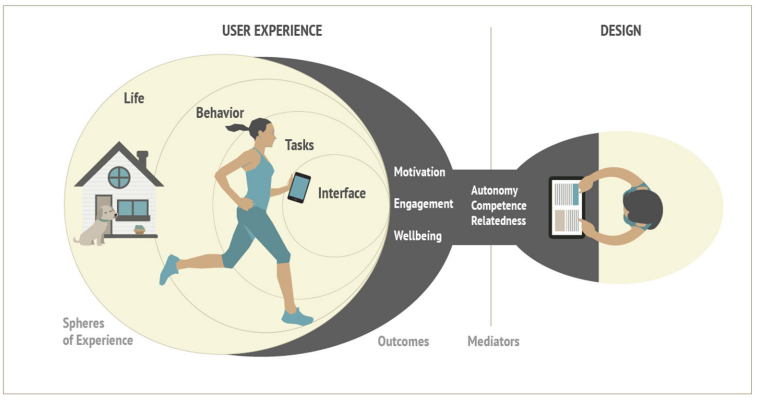
Taxonomy of Human Motivation
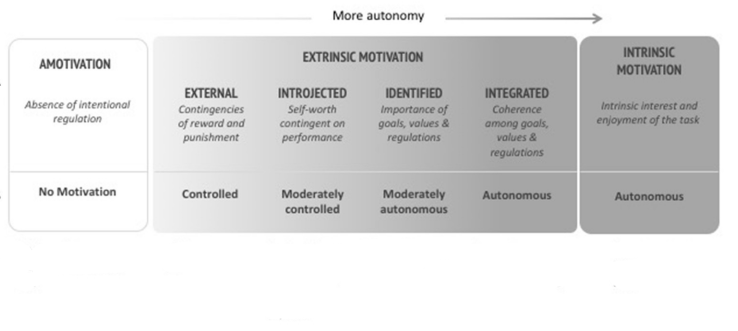
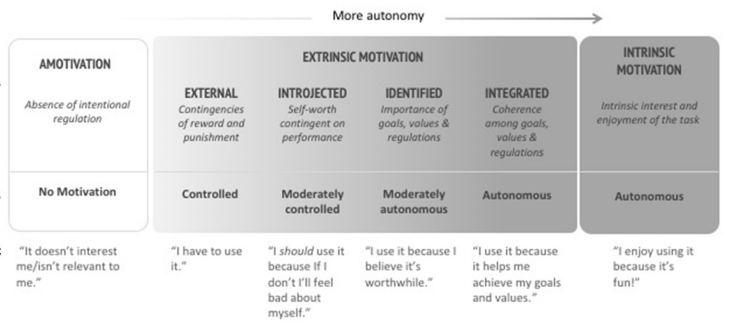
Any Questions?
Prepare for the next session
To prepare for the next session, please go to https://github.com and create a new user account (if you do not have one already) so that you can follow along and participate in next week’s exercise!
Session 04: Structuring a Heterogeneous Field — The Basics of Markdown and GitHub

Resources for this session
What is the plan for the next weeks?
Why use GitHub?
Markdown Exercise
Github Intro
Session 10: Systematization — What Constitutes Autonomy in Digital Communication?

Resources for this session
Baumeister & Leary (1997)
Course Overview
Weekly Sessions
| Session | Topic |
|---|---|
| 07.06.23 | Wiki Project — No class! |
| 14.06.23 | Systematization: What Constitutes Autonomy in Digital Communication? |
| 21.06.23 | Systematization: What Constitutes Autonomy in Digital Communication? |
| 28.06.23 | Systematization: What Constitutes Autonomy in Digital Communication? |
| 05.07.23 | Synthesis: SDT-focused Perspectives on Digital Autonomy and Their Contribution to the Field |
| 12.07.23 | Synthesis: Other Perspectives on Digital Autonomy and Relation to SDT |
| 19.07.23 | Concluding Thoughts & Evaluation |
Systematization
Possible options:
- Textual/narrative
- Tabular
- Numerical/statistical
- Graphical
Goals of Literature Reviews
based on Baumeister & Leary (1997)
- Theory development
- Theory evaluation
- Survey the state of knowledge
- Problem identification
- Historical account
Common Mistakes
based on Baumeister & Leary (1997)
- Inadequate introduction (e.g., lack of theoretical framework)
- Inadequate coverage of evidence (e.g., amount of detail)
- Lack of integration (e.g., lack of “take-home message”, how do the studies fit together?)
- Lack of critical appraisal (e.g., methodological weaknesses)
- Failure to adjust conclusions (e.g., ignoring previously mentioned critique)
- Blurring assertion and “proof” (e.g., mixing up ideas and evidence)
- Selective review of evidence (e.g., ignoring studies that don’t fit the narrative)
- Focusing on researchers rather than the research (e.g., “XY said that…”)
- Stopping at the present (e.g., ignoring implications for future research)
Theoretical Integration
- Do not only describe the procedures and observations of various studies but relate them to the theoretical issues
- Synthesis: a summary of individual study findings which juxtaposes them, often to identify patterns and provide a basis for (further) integration
- Analysis: methods that critically assess the synthesized evidence, try to explore/explain heterogeneity, and ultimately answer the RQs
Critical Appraisal
- Do not critique individual studies, but groups of studies
- Composite quality scoring (CQS): Uses a pre-validated quality appraisal sheet that captures a composite index of overall study quality (rather uncommon)
- Assessment of best practice:
- Sampling (e.g., selection, assignment to conditions)
- Design (e.g., blinding, active or passive controls)
- Measurements (e.g., reliability, internal and external validity, construct validity)
- Analysis procedures (e.g., validity of statistical procedures)
Any Questions?
Requirements for the Presentation
- Build groups based on what makes sense for systematization, e.g.,
- common boundary condition (e.g., person, situation, time, role of autonomy)
- common (media) use case (e.g., mHealth, GDPR, …)
- Always return to the following two questions:
- What constitutes autonomy in digital communication (how does you perspective contribute to that?)
- How does this relate to individuals’ autonomy need experiences as defined in SDT?
Remember the research questions
- RQ1: What are the mechanisms that are proposed to connect digital media use and autonomy need experiences?
- (RQ2: Which research perspectives can be identified in the study of digital autonomy?)
- RQ3: What are the theoretical approaches that are used by these perspectives and how do they relate to each other?
- RQ4: Which of these perspectives focus on individual perceptions of digital autonomy or autonomy need experiences that relate to digital media use?
- RQ5: How are individual perceptions of digital autonomy or autonomy need experiences that relate to digital media use studied empirically?
Formal Structure
- Groups:
- Digital Healthcare (max 3)
- Digital Media Use (max 3)
- Digital Pedagogy (1)
- Digital Power Structures (1)
- Can be split again for term paper
- Length of 5-7 minutes (prepare no more than 5 slides!)
- Focus on theory integration and synthesis in your presentation
- Always return to the following two questions:
- What constitutes autonomy in digital communication (how does you perspective contribute to that?)
- How does this relate to individuals’ autonomy need experiences as defined in SDT?
- Group presentation is a work-in-progress!
- Will not be graded!
- You will give and receive feedback
- Will be the basis for your term paper
Any Questions?
References

